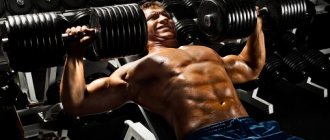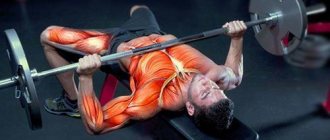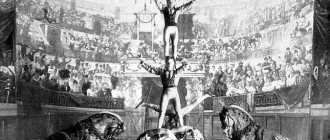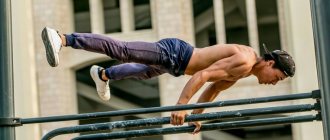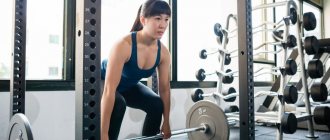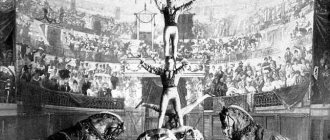“Some people with thin legs are stronger than people with thick legs - Why? Because the power lies in the tendons, in those invisible hard tissues that are second in density only to bones. Without tendons, a person would turn into jelly. But the tendons need to be trained. From my experience, one can be convinced that a large man does not necessarily have to be strong, but a man of modest build does not have to be weak.
I don't believe in big muscles unless there's real big tendon power next to them. You can see physical fitness enthusiasts who have quite large muscles. But what good are they if there is no powerful foundation - developed tendons. They are unable to fully utilize the strength of their muscles during an actual test of strength. And therefore their power is only an illusion.
Tendons increase their strength best when their power is applied to some almost immovable object. They become stronger from resistance than from movement.”
Alexander Zass, or Iron Samson, created an ingenious system for developing strength. Here the supporting part of his system is presented: the development of tendon strength.
“I never strived for big muscles, believing that the main thing was strong tendons, willpower and the ability to control my muscles. When I started performing in the circus as an athlete, my biceps were only 38 centimeters. But the public needs a look, and I had to increase them to 42 centimeters through exercises with dumbbells and self-resistance exercises” (from a letter to Yuri Shaposhnikov).
“Big biceps are not a sign of strength any more than a big belly is a sign of good digestion.”
Alexander Zass achieved phenomenal strength density with the help of tendon exercises. Short, weighing 66 kg, at the beginning of his wrestling and athletic career, he caused confusion among spectators with his exploits: he defeated huge opponents, broke chains and horseshoes, tied metal rods with a bow, restrained horses rushing in different directions... Because of this confusion, Zass had to gain more weight muscle mass to rid viewers of suspicions of deception. However: throughout his entire circus career, his weight never exceeded 80 kg.
Tendon exercises have been generally known since ancient times. People's strongmen lifted and carried huge stones and large animals, practiced bending and unbending metal rods and horseshoes, dragged tree-boats-carts behind them, restrained rushing bulls and horses... In ancient Rome, athletes dressed in iron robes weighing 200-300- 400 kg and so climbed onto the platform...
But it was Zass who was the first to be lucky enough to recognize the system in the phenomenon and present it to the world. This happened in 1924.
“We need to develop what underlies the muscle, especially the tendon, not the volume of the muscle.”
In the early 60s, naive Americans rediscovered the Sass effect, calling these exercises isometric and static. Since then, tendon exercises have become part of active sports practice: to develop strength, to overcome dead spots, to form new trajectories of power movements. But here they remain separate, isolated exercises. But the system already exists!
Alas. Authorities in sports and science prefer to keep this fact in the shadows and, as a result, are forced to fool ordinary people. After all, the tendon system is phenomenal in many ways: it can be practiced with a minimum of space, equipment, and time and with excellent effect. It is no coincidence that the circus strongmen of our time - Gennady Ivanov and Ivan Shutov - used the Zass system as the basis for the development of strength.
That's why experts have to look for sunspots. They will announce that isometric straining is harmful to the heart, blood vessels, and nerves, especially those who are unprepared, such as young people or amateurs (this is not true); then they will tell you how dynamic training (complex!) surpassed isometric training (simple!); then they will remember about potentially all kinds of micro and larger tears in muscle tissue and other irreparable dangers of maximum strain.
Another way: mix concepts. They say this is the same as Anokhin’s volitional gymnastics. Here's a good home isometric complex without projectiles. Only 4-6 seconds and only after a year you can increase the voltage time to 8 seconds. And 12 seconds or more is a direct threat to health. Listen to yourself: if you get a headache, quit this disastrous business immediately. Stress only while inhaling. Train for no more than 15 minutes!
The usual thing is the opposite. The real blemish is the recent history of isometrics. In the early 60s, Bob Hoffman organized the release of miraculous power racks for isometric exercises and in his magazine “Strength and Health” he touted with all his might the cool achievements of Bill March and Louis Riquet, who added several hundred pounds to their all-around competition in six months. Many have made decent progress, but no one has been able to repeat the fantastic breakthrough of March and Rike. And finally it turned out that there was another reason for their rise - steroids. The scandal simultaneously and permanently damaged the reputation of isometrics.
Nevertheless: this was the first large-scale experiment. Equipment was plentiful, and a few years later a scientific study of 175 athletes doing isometrics showed an average weekly 5% increase in strength. Wow!
It was at this time that isometrics became firmly established in world-class sports practice, but at the same time remained narrowly focused, boring and far from ordinary amateurs.
But how simple it could be: if we reissue two original books by Alexander Zass and the book “The Amazing Zass” of 1925, if we show how exactly chain voltages act - by themselves and in the system, if we still take into account new experience “in favor” of the system Zassa.
In the meantime, let's answer the objections:
• The Zass system also includes dynamic exercises with a bag. And apparently the newest revelations of the Gurias of bodybuilding are slowly approaching the Zass system. On the other hand, progress is an objective thing and they also have something to improve - to update the Zass system.
• Complex tendon training includes not only statics, but also “pumping” of the entire joint volume by tension. That is, the development of the tendon spring, the development of the connection of the tendons with the joint and with the muscle, the distribution of the tendon force density over the entire motor range of motion, the development of accompanying balances-regulations-controls. And it’s natural to use different modes of tendon training: for example, stops, carrying weights, standing like a “pillar” or “rider” or just like that, holding a barbell with your body... warming up, mobilizing, maximum...
• The danger of straining for health is directly related to disturbances in energy and physiological regimes: first of all, nervous and improper breathing, then a disruption of the processes of prompt and long-term recovery, and finally, this is a practice of narrow-private use leading to distortions in the overall energy exchange. All these syndromes can be reproduced without isometrics - in any activity, and even more so in sports.
• Gymnastics Anokhina lives next door and some of her exercises can very well complement tendon gymnastics. But!! — volitional gymnastics is muscular gymnastics. Its closest relatives are Hermes gymnastics, hatha yoga, and stretching.
• However, a direct close relative did appear. This is Vladimir Fokhtin’s autonomous gymnastics, self-resistance gymnastics. She, too, has a hard time with experts: they will either declare her to be Anokhin’s gymnastics, or describe her usefulness as tasks for toning up ordinary people or as a temporary means for business trips, or remember the dangers of isometric exercises. Indeed: Fokhtin’s gymnastics develops tendons, develops joints, develops muscles.
At the same time, it requires a minimum of space and absolutely no shells. True, the author followed the lead of the experts and somewhat overcomplicated the starting course to 88!!! exercises. It's not even a matter of quantity - it's a complete system, the problem is the structure of the presentation of these exercises. Plus, the author carefully distanced his gymnastics from isometrics and self-exertion. But in fact, Fokhtin took the next step in the development of athleticism and tendon gymnastics.
• About the 6-second mode, in which the maximum force is 2-3 seconds. Unfortunately, I don’t know Zass’s own opinion about this. But here's what we know:
a) Zass in prison practiced 15-20 second tensions, therefore, under normal conditions and with normal nutrition, he could use minute tensions.
b) In the first 6-8 seconds, the ATP reserve is burned, then glycogen comes into play and fat is ignited at 40 seconds. The problem is that the isometric way of expending and restoring energy conflicts with the aerobic dynamic way. In general, if you don’t change anything, then you really have to choose “either or”. If you choose isometrics, then naturally 4 modes of tension are revealed: 6 seconds, 15-20 seconds, 1 minute, 3-6 minutes. But they still need to be awakened, treated, developed... Otherwise, it is very easy to overtrain and fall into a viscous pit of distress.
The tendon system of developing strength using chains is original and fresh to this day. The Zass system allows you to quickly increase strength, strengthens ligaments and tendons, creating a foundation for the natural development of muscles.
Note for women: proper performance of tendon exercises does not increase muscle volume, does not enlarge veins, includes subcutaneous fat in the overall energy exchange (promotes resorption and improvement of the skin), improves character and the ability to stand up for oneself. True, you will have to show taste and ingenuity in selecting exercises.
Tendon exercises can be performed using different equipment - a metal rod, chains, a thick cord, a wooden stick.
Training principles of Alexander Zass
We can say that life itself revealed to Alexander Ivanovich the principles of increasing strength. After all, while still a teenager, Shura (as his parents affectionately called him) due to circumstances had only a heavy barrel as a training implement. Day after day, month after month, he struggled to lift her even a millimeter from the ground.
Nothing worked.
But Shura noticed that in everyday life he became much stronger. The heavy saddle, which he usually had difficulty dragging to the horse, became lighter every day. At that time, Alexander did not yet realize that he had discovered the principle of training, which would later bring him the glory of Iron Samson!
Principle #1
What was the secret of Zass’s training? Let's remember anatomy for a moment. Imagine two bones connecting through a joint.
To make them move relative to each other, muscles are needed. The latter are attached to the bones through tendons. As Alexander Zass himself said: tendons are the second strongest tissue after bones, and it is thanks to these strong cords that we are able to develop maximum strength.
So, the secret of his strength is hidden in tendon training!
I think you know that in arm wrestling it is not the one who has the biggest muscles who is strong, but the one who has stronger attachments of these muscles. And if you ask an arm wrestler how he trains, he will answer that he pays a lot of attention to isometric exercises. After all, it is this type of load that best increases the strength of our tendons!
While training with a barrel in his youth, Shura did not yet suspect that he was performing isometric exercises. But subsequently Zass developed a whole system of exercises based on resistance to weights through static (immobile) muscle tension.
Principle No. 2
The second principle of Iron Samson's training is to increase muscle volume through dynamic exercises. Despite the fact that Alexander Zass gave preference to developing the strength of tendons and ligaments, he still trained in the classic “Kachkovsky” manner.
Increasing muscle mass for Samson was more of a necessary measure than a true desire for the figure of Apollo. It’s just that one day he realized how important a presentable appearance is if you work for the public. By the way, despite all the strength records with a height of 166 cm, his weight hardly exceeded 70 kg. Since then, Iron Zass began to actively use dynamic exercises to gain muscle mass.
Training and performances
As the circus performer himself recalled, most often he was asked the question of how he could become so strong. He answered honestly, without embellishment or exaggeration. He said that strength is the result of exhausting work and strong tension not only of physical, but also of spiritual strength. He was always honest about the fact that his success was entirely based on constantly working to the limit.
Alexander Zass never shrouded himself in any fables and myths that he was born with such incredible strength and is a miracle of nature. He simply persistently pursued his goal. Alexander Zass's system will impress anyone, because all his life he adhered to a very strict regime and constantly trained. If we try to briefly and succinctly describe his life, it will consist of periods of training and performances. In fact, these are the two main activities that occupied the talented and persistent man throughout his life.
It seemed simply incredible that this man remained true to himself and his views even in his old age. So, in old age he continued to work. Of course, he could no longer demonstrate any strength numbers, but nevertheless continued his activities as a trainer. And yet, he could not resist showing off several power tricks during his performance, which only further warmed up and excited the audience. Around this age, he was still shocking onlookers by holding a structure with his teeth on which two lions sat. He could not only hold them, but also walk on stage with them.
However, the last public performance took place when the circus performer was 66 years old. After that, he only worked behind the scenes and trained animals. He really enjoyed working with horses, dogs, monkeys and ponies. He also trained large animals such as lions and elephants.
A set of dynamic exercises
While still a young man and working in a circus, Shura used a bag of sawdust for his training. It would seem, what benefit could this product have? But the smart circus performer Zass found a way to turn an ordinary bag into a full-fledged training apparatus. And with a progressively increasing load!
First, he filled the bag to capacity with sawdust, obtaining a 7-kilogram projectile. Alexander already knew then that muscles grow from evenly increasing load. Therefore, every few days I replaced a handful of sawdust with sand. Until the whole bag was filled with this bulk filler.
But even this was not enough for the strong man. He began to fill the bag with lead shot. This made it possible to increase the weight of the projectile to 70 kg!
Subsequently, Iron Samson described in detail his set of exercises, which consisted of:
- Raising the bag from the floor to the chest and pressing overhead. The exercise is reminiscent of a weightlifting barbell push, but without the use of inertia.
- Squats with overhead bag press. Moreover, simultaneously with the squat, you need to squeeze the projectile upward.
- Presses and rotations with one hand of the bag above your head. The exercise can be modified to develop finger development. At the top point, you need to additionally press on the bag with each finger in turn, trying to raise the projectile even higher.
- Throwing the bag over your head from one hand to the other. At the same time, with each subsequent workout, try to throw the bag higher.
- Throwing the bag over your head from your arms to your shoulders. In the starting position, the bag is held in the hands at knee level. Then it is thrown up so that it lands on the shoulder blades and neck.
- Presses and lifts of the bag with straight arms from behind the head, lying on the floor. The exercise resembles a mixture of two movements: bench pullovers and bench press.
- Lifting the bag with your legs while lying on the floor. You can call the exercise analogous to a platform press. Just don't drop the bag on yourself.
- Exercises “Lumberjack” with a bag. The name speaks for itself.
All exercises, with the exception of lifting the bag with your legs, should be completed in 10-15 repetitions. And perform the leg press until the muscles feel tired.
The strongman strongly recommends monitoring your breathing, exhaling forcefully. And after each approach he advises to perform breathing exercises.
Be sure to watch the video:
Mass gain
At first, Alexander Zass performed only as a wrestler; the owner of the circus did not allow him to perform power routines, because... believed that people would stop going to performances. If in wrestling the viewer is interested in watching how the puny Zass escapes from grabs, and hope that they will suddenly harm each other - there are enough stories for a week, then the power moves will humiliate the viewer: “The runt Zass will come out, not tall enough, puny in appearance. We announce to the public his weight - 67 kilograms. A runt, definitely. And suddenly this little guy starts to break the chains! What does the person sitting in the hall think? When he sees little Zass, he’ll be convinced that he’s being fooled here, it’s all a complete scam.” It was decided to fatten Alexander - a small trick. A month of quiet life and special exercises to make the muscles grow.
Now Alexander’s day began with a three-kilometer run. Then training with iron rods - I bent them on my knee, tied them in a knot, curled them in a spiral. He learned to break chains in two movements - he takes two adjacent links, squeezes them with his fingers, turns back and forth until it stops, and the chain breaks. Development of the pectoral and back muscles. Having loaded the platform placed on his chest with stones, Zass took several deep breaths, then rested, after which he stood on the “bridge” and bent over. The morning classes ended with a series of exercises with a bag. The pillow-shaped bag was first filled with sawdust and weighed 7 kg. Every day Zass poured out a handful of sawdust and added a handful of sand. When all the sawdust was replaced with sand, he began pouring sand and adding shot. In the end, the bag began to weigh about 70 kg.
The second time Zass trained in the evening. I worked on my balance and practiced horse riding and vaulting. Vaulting is the performance of a set of special gymnastic exercises on a horse moving in a circle at various gaits - walk, trot, gallop.
A set of isometric exercises
As we have already found out, the basis of Iron Samson’s strength was strong tendons and ligaments. He strengthened them with isometric exercises. All that was required for classes was a chain and straps, which could be made from belts. It turned out to be a kind of analogue of an expander, only inextensible.
So, I present to you a complex for increasing strength from Alexander Zass:
- Stretching the chain over your head.
- Stretch the chain with bent arms in front of the chest.
- Stretching the chain behind your back.
- The chain stretch is similar to the bench press.
- Stretching the chain with the chest.
- An exercise reminiscent of shrugs. Pass the chain under your foot and take the loose ends in your hands.
- Triceps and deltoid chain stretches.
- Stretching the chain with your arm bent at the elbow.
- Stretching the chain by hand. Pull the chain with your right hand bent while holding the other end of the chain with your straight hand. Change hands.
- Stretching a chain thrown over the thigh.
- Stretching the chain in a prone position (not shown in the picture).
- Handstand chain stretch.
- Stretching the chain using the muscles of the neck and back.
- Stretch the chain using the quadriceps and biceps muscles.
Samson strongly recommends following certain rules when performing static exercises:
- Breathe calmly while doing the exercises.
- Perform the exercise 1-5 times, resting for 30 to 90 seconds. If necessary, you can rest more.
- Monitor your heartbeat, if your heart is pounding, then reduce your tension.
- Join your training gradually, starting with 5 seconds of tension, gradually increasing the time to a minute.
- Alternate strength training with submaximal efforts and training with less tension (by 10-15% according to subjective assessment).
I agree, the exercises are not simple, so to understand the correct technique, watch the video:
Nutrition
Alexander considered daily training to be the key to his phenomenal strength and good health. In addition to the hard training developed according to his program, he ran 3 km daily, did gymnastics, followed an exceptionally healthy lifestyle , did not drink or smoke. The athlete always tried to eat right and rest, although he did not leave any special recommendations on diets and daily routine for his successors.
We covered this topic in more detail in the following articles:
- Breakfast of the champion
- Diet Basics
- Nutrition during training
- What you need and what is healthier to eat for breakfast
- All about calories
A few final words
In a book dedicated to the life of Alexander Ivanovich Zass, the author mentioned one good phrase of the great strongman: “Large biceps is not a criterion of strength, just as a large belly is a sign of good digestion.” It reflects the deep knowledge and invaluable experience of a circus strongman. It’s not without reason that his training methods received a lot of positive feedback from athletes and professional circus performers of the highest level!
Subscribe to article updates. Be strong friends, train and strengthen your body with us! See you!
Achieving your dreams
When Alexander began working in the circus, he mastered many genres at a very high level: aerial gymnastics, horse riding, power wrestling. For some time he was an assistant to the great trainer Anatoly Durov. Later he assisted the strongman Mikhail Kuchkin, where his first practice took place. Kuchkin correctly predicted that Zass would become a celebrity thanks to his strength, and despite his height and weight.
The height of the already adult Alexander was only 167.5 cm, and weighed less than 80 kg. The girth of the chest when inhaling was 119 cm, biceps - 38 cm. Later I pumped up my biceps to 41 for a more impressive appearance in the arena.
All of Zass’ routines were very popular with the public, be it hammering nails into a board with his hand, or lifting several people with one hand, or holding a platform with wrestlers in his teeth, or stretching with horses, or breaking a thick chain with his fingers...
Second extreme
To counter the misconception that bulky muscles guarantee strength, there is another: “Isometrics are all you need to develop strength.” Of course, Zass isometric exercises alone cannot provide significant strength gains. Don't forget about the muscles that help move objects; bones that can support significant weight and pressure; the cardiovascular system, which supplies muscle tissue with oxygen; and finally, about the mind, which allows you to cope with all this without causing harm to your health.
According to the creator of isometric exercises, Alexander Zass, work on developing strength should have the following structure:
- Strength of will.
- Ability to control muscles.
- Tendon strength.
- Correct breathing.
When preparing any athlete, special attention should be paid to strength training, and true strength, as we have already figured out, does not exist without the strength of the tendons.
Sources
- Zassy // Military Encyclopedia: / ed. V. F. Novitsky. - St. Petersburg. ; [M.]: Type. t-va I. D. Sytin, 1911-1915.
- Volkov S.V.
Generality of the Russian Empire. Encyclopedic dictionary of generals and admirals from Peter I to Nicholas II. Volume II. L—Y. M., 2009. - P. 540. - ISBN 978-5-9524-4166-8 - Zatvornitsky N.M.
Zass, Alexander Pavlovich // Russian Biographical Dictionary: in 25 volumes. - SPb.-M., 1896-1918. - From the notes of N. I. Lorer // “Russian Archive”. - 1874 - No. 2 and 9
- Ismailov E. E.
Golden weapon with the inscription “For bravery.” Lists of cavaliers 1788-1913. M., 2007. - S. 89, 200, 432, 481. - ISBN 978-5-903473-05-2 - Centenary of the War Ministry. 1802-1902. Imperial Main Apartment. History of the sovereign's retinue. Eighteenth century. Compiled by Colonel V.V. Quadri
. - St. Petersburg, 1902. - P. 366, 420, 456 - Miloradovich G. A.
List of persons in the retinue of their majesties from the reign of Emperor Peter I to 1886. - Kyiv, 1886. - P. 96. - (Comment by A. A. Podmazo)
- List of generals by seniority. Corrected as of June 20. - St. Petersburg, 1840. - P. 72.
Advantages
The Zass isometric exercise system has many advantages:
- The lesson lasts only 15 minutes.
- There is no need for special equipment or premises.
- Zass isometric exercises can increase tendon strength, which is the key to true human strength.
- For certain types of activities, you can choose the most suitable exercises.
- Anyone can practice this method: both a person recovering from an injury and a professional athlete preparing for a competition.
- For any part of the body there are separate exercises by Zass (“Iron Samson”).
- The body's energy is spent only on tension in the joints, without being wasted on movements that cause muscle fatigue.
- Increased flexibility.
- Low probability of injury.
Bodybuilder Mistake
The problem with many bodybuilders is that they have a lot of muscle tissue, but not enough strength in the tendons. Thus, the strength potential of the muscles is not fully used. Bodybuilding enthusiasts focus on working the muscles in isolation, so tendon strengthening is simply ignored in their training. However, bodybuilding means “building the body”, not building strength. But for weightlifters, isometrics really wouldn’t hurt.
